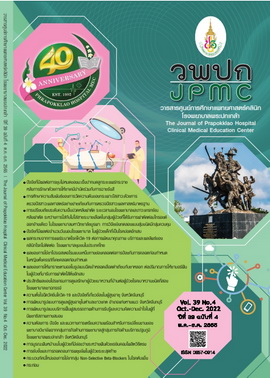Factors Affecting the Length of Stay for Children Hospitalized with Community-Acquired Pneumonia
Main Article Content
Abstract
BACKGROUND: Community-acquired pneumonia is an acute form of lower respiratory infection that is most common in children. The length of stay in hospital depends on the characteristics of the patient and hospital, though several clinical factors may impact the pneumonia-associated length of stay.
OBJECTIVES: To determine the factors affecting the length of stay for patients with pneumonia and evaluate the average length of hospital stay, death rate and epidemiology of patients with pneumonia.
METHODS: This study is a retrospective cohort study of children aged 1 month to 15 years old who were admitted to Prapokklao Hospital with community-acquired pneumonia between October 2018 and September 2019. Multivariate regression analysis was used to determine the adjusted variables that affected the length of hospital stay.
RESULTS: Based on the study of the medical records of 230 patients with community- acquired pneumonia admitted to Prapokklao Hospital, patients with prolonged hospital stay spent an average of 8 days in hospital (p<0.01). The factors using the heated humidified high flow nasal cannula (HHHFNC) (p=0.001), preterm (p=0.02) and tachypnea (p=0.04) were found to be significantly associated with a longer length of stay. Mortality was not found in the study. This disease usually occurs during the rainy season, with the highest prevalence in September.
CONCLUSIONS: Using the heated humidified high flow nasal cannula (HHHFNC), preterm and tachypnea were considered factors affecting prolonged length of stay for patients with community-acquired pneumonia at Prapokklao Hospital.
Article Details

This work is licensed under a Creative Commons Attribution-NonCommercial-NoDerivatives 4.0 International License.
References
Department of Disease Control, Ministry of Public Health. Pneumonia situation [Internet]. 2019 [cited 2020 Apr 6]. Available from: https://ddc.moph.go.th/doe/publishinfodetail.php?publish=7211&deptcode=doe
Department of Disease Control, Ministry of Public Health. Annual epidemiological surveillance report 2019. Pneumonia (Internet). 2019 [cited 2020 Apr 6]. Available from:https://ddc.moph.go.th/uploads/publish/1129820210409083616.pdf
The office of Disease Prevention and Control 8 Udonthani. Weekly Report Vol.30 (Internet). 2020 [cited 2020 Nov 30]. Available from: http://odpc8.ddc.moph.go.th/upload_epi_article/lSNkYZBD49AO2wPu5ao8.pdf
McAllister DA, Liu L, Shi T, Chu Y, Reed C, Burrows J, et al. Global, regional, and national estimates of pneumonia morbidity and mortality in children younger than 5 years between 2000 and 2015: a systematic analysis. Lancet Glob Health [Internet]. 2019 [cited 2022 Apr 6]; 7:e47-e57. Available from: https://doi.org/10.1016/s2214-109x(18)30408-x
Self WH, Grijalva CG, Zhu Y, McNaughton CD, Barrett TW, Collins SP, et al. Rates of emergency department visits due to Pneumonia in the United States, July 2006-June 2009. Acad Emerg Med 2013;20:957-60.
Neuman MI, Shah SS, Shapiro DJ, Hersh AL. Emergency department management of childhood pneumonia in the United States prior to publication of national guidelines. Acad Emerg Med 2013;20:240-6.
Menéndez R, Cremades MJ, Martínez-Moragón E, Soler JJ, Reyes S, Perpiñá M. Duration of length of stay in Pneumonia: influence of clinical factors and hospital type. Eur Respir J 2003; 22:643-8.
Gereige RS, Laufer PM. Pneumonia. Pediatr Rev 2013;34:438-56.
Pediatric Infectious Disease Society of Thailand. Guidelines acute respiratory infections in children 2019. Bangkok: Pediatric Infectious Disease Society of Thailand; 2019.
Gajewska M, Lewtak K, Scheres J, Albrecht P, Gorynski P. Trends in hospitalization of children with Bacterial Pneumonia in Poland. Cent Eur J Public Health 2016;24:188-92.
Azmi S, Aljunid SM, Maimaiti N, Ali AA, Muhammad Nur A, De Rosas-Valera M, et al. Assessing the burden of Pneumonia using administrative data from Malaysia, Indonesia, and the Philippines. Int J Infect Dis 2016;49:87-93.
Jakhar SK, Pandey M, Shah D, Ramachandran VG, Saha R, Gupta N, et al. Etiology and risk factors determining poor outcome of severe Pneumonia in under-five children. Indian J Pediatr 2018;85:20-4.
Bunjoungmanee P, Rotejaratpaisan A, Tangsathapornpong A. Epidemiology, clinical manifestation and risk factors of respiratory syncytial virus infection in children at Thammasat University hospital. Thammasat Medical Journal 2016;16:370-8.
Shan W, Shi T, Chen K, Xue J, Wang Y, Yu J, et al. Risk factors for severe community-aquired Pneumonia among children hospitalized with CAP younger than 5 years of age. Pediatr Infect Dis J 2019;38:224-9.

